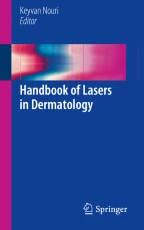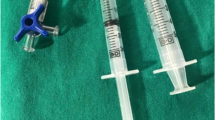Laser Treatment for Spider Veins

Increased venous pressure causes dilation of normal leg veins creating varicose or spider veins. This can be a consequence of loss of smooth muscle tone causing valvular insufficiency or more rarely deep vein thrombosis. The treatment of choice for eliminating spider veins of the leg is sclerotherapy, although the use of laser technology as a safe and relatively painless alternative has been long anticipated. We will discuss in this chapter some lasers and light therapies that have been used, including the argon, copper bromide, Nd:YAG, diode, long-pulse infrared Alexandrite and pulsed dye lasers, as well as the intense pulsed light. These are indicated for vessels of different sizes and depths and have different clearance rates. Unfortunately, laser therapy has not been found to be as effective, but it can be used as a supplementary form of therapy. Development of new technologies or the significant improvement of present technologies, as well as adjuvant therapies should be further explored.
This is a preview of subscription content, log in via an institution to check access.
Access this chapter
Subscribe and save
Springer+ Basic
€32.70 /Month
- Get 10 units per month
- Download Article/Chapter or eBook
- 1 Unit = 1 Article or 1 Chapter
- Cancel anytime
Buy Now
Price includes VAT (France)
eBook EUR 85.59 Price includes VAT (France)
Softcover Book EUR 105.49 Price includes VAT (France)
Tax calculation will be finalised at checkout
Purchases are for personal use only
Similar content being viewed by others

Leg Veins
Chapter © 2019

Chemical Superficial Vein Ablation
Chapter © 2014

Sclerotherapy for Varicose Veins
Article 15 August 2021
References
- Weiss RA, Weiss MA, Beasley KL. Sclerotherapy and vein treatment. New York: McGraw-Hill; 2013. Google Scholar
- Nouri K, editor. Lasers in dermatology and medicine. New York: Springer; 2011. Google Scholar
- Goldman MP, Sadick NS, Weiss RA. The history of dermatology in American phlebology. Dermatol Surg. 2000;26(7):616–21. ArticleCASPubMedGoogle Scholar
- Weiss RA, Dover JS. Laser surgery of leg veins. Dermatol Clin. 2002;20(1):19–36. ArticlePubMedGoogle Scholar
- Sadick NS, Weiss RA, Goldman MP. Advances in laser surgery for leg veins: bimodal wavelength approach to lower extremity vessels, new cooling techniques, and longer pulse durations. Dermatol Surg. 2002;28(1):16–20. Review. PubMedGoogle Scholar
- Weiss RA, Sadick NS. Epidermal cooling crystal collar device for improved results and reduced side effects on leg telangiectasias using intense pulsed light. Dermatol Surg. 2000;26(11):1015–8. ArticleCASPubMedGoogle Scholar
- Tan OT, Murray S, Kurban AK. Action spectrum of vascular specific injury using pulsed irradiation. J Invest Dermatol. 1989;92(6):868–71. ArticleCASPubMedGoogle Scholar
- Anderson RR, Parrish JA. Microvasculature can be selectively damaged using dye lasers: a basic theory and experimental evidence in human skin. Lasers Surg Med. 1981;1(3):263–76. ArticleCASPubMedGoogle Scholar
- Smithies DJ, Butler PH. Modelling the distribution of laser light in port-wine stains with the Monte Carlo method. Phys Med Biol. 1995;40(5):701–31. ArticleCASPubMedGoogle Scholar
- Dierickx CC, Casparian JM, Venugopalan V, Farinelli WA, Anderson RR. Thermal relaxation of port-wine stain vessels probed in vivo: the need for 1–10 millisecond laser pulse treatment. J Invest Dermatol. 1995;105:709–14. ArticleCASPubMedGoogle Scholar
- Braverman IM. Ultrastructure and organization of the cutaneous microvasculature in normal and pathologic states. J Invest Dermatol. 1989;93:2S–9S. ArticleCASPubMedGoogle Scholar
- Kienle A, Hibst R. Optimal parameters for laser treatment of leg telangiectasia. Lasers Surg Med. 1997;20(3):346–53. ArticleCASPubMedGoogle Scholar
- Weiss RA, Weiss MA. Early clinical results with a multiple synchronized pulse 1064 NM laser for leg telangiectasias and reticular veins. Dermatol Surg. 1999;25(5):399–402. PubMed PMID: 10469080. ArticleCASPubMedGoogle Scholar
- Sommer A, Van MP, Neumann HA, Kessels AG. Red and blue telangiectasias. Differences in oxygenation? Dermatol Surg. 1997;23(1):55–9. ArticleCASPubMedGoogle Scholar
- de Faria JL, Moraes IN. Histopathology of telangiectasias associated with varicose veins. Dermatologica. 1963;127:321–9. ArticleGoogle Scholar
- Greve B, Raulin C. Laser therapy for vascular lesions. Hautarzt. 2006;57(6):537–48. ArticleCASPubMedGoogle Scholar
- Weiss RA, Sadick NS, Goldman M, Weiss MA. Post-sclerotherapy compression: controlled comparative study of duration of compression and its effects on clinical outcome. Dermatol Surg. 1999;25(2):105–8. ArticleCASPubMedGoogle Scholar
- McCoppin HH, Hovenic WW, Wheeland RG. Laser treatment of superficial leg veins: a review. Dermatol Surg. 2011;37(6):729–41. CASPubMedGoogle Scholar
- West TB, Alster TS. Comparison of the long-pulse dye (590–595 nm) and KTP (532 nm) lasers in the treatment of facial and leg telangiectasias. Dermatol Surg. 1998;24(2):221–6. ArticleCASPubMedGoogle Scholar
- Spendel S, Prandl EC, Schintler MR, Siegl A, et al. Treatment of spider veins with the KTP (532 nm laser) – a prospective study. Lasers Surg Med. 2002;31:194–201. ArticlePubMedGoogle Scholar
- Fournier N, Brisot D, Mordon S. Treatment of leg telangiectases with a 532 nm KTP laser in multipulse mode. Dermatol Surg. 2002;28:564–71. CASPubMedGoogle Scholar
- Bernstein EF, Kornbluth S, Brown DB, Black J. Treatment of spider veins using a 10 millisecond pulse-duration frequency doubled neodymium YAG laser. Dermatol Surg. 1999;25(4):316–20. ArticleCASPubMedGoogle Scholar
- Kono T, Yamaki T, Erçöçen AR, Fujiwara O, Nozaki M. Treatment of leg veins with the long pulse dye laser using variable pulse durations and energy fluences. Lasers Surg Med. 2004;35(1):62–7. ArticlePubMedGoogle Scholar
- Dover JS, Sadick NS, Goldman MP. The role of lasers and light sources in the treatment of leg veins. Dermatol Surg. 1999;25(4):328–35; discussion 335–6. ArticleCASPubMedGoogle Scholar
- Reichert R. Evaluation of the long-pulsed dye laser for treatment of leg telangiectasia. Dermatol Surg. 1998;24:737–40. CASPubMedGoogle Scholar
- Goldman MP, Sadick NS, Weiss RA. Treatment of spider veins with the 595 nm pulsed-dye laser. J Am Acad Dermatol. 2000;42(5 Pt 1):849–50. No abstract available. ArticleCASPubMedGoogle Scholar
- Hohenleutner U, Walther T, Wenig M, Baumler W, Landthaler M. Leg telangiectasia treatment with a 1.5 ms pulsed dye laser, ice cube cooling of the skin and 595 vs 600 nm: preliminary results. Lasers Surg Med. 1998;23(2):72–8. ArticleCASPubMedGoogle Scholar
- Bernstein EF. The new-generation, high-energy, 595-nm, long pulse-duration pulsed-dye laser improves the appearance of photodamaged skin. Lasers Surg Med. 2007;39(2):157–63. ArticlePubMedGoogle Scholar
- Lee HI, Lim YY, Kim BJ, Kim MN, Min HJ, Hwang JH, et al. Clinicopathologic efficacy of copper bromide plus/yellow laser (578 nm with 511 nm) for treatment of melasma in Asian patients. Dermatol Surg. 2010;36(6):885–93. ArticleCASPubMedGoogle Scholar
- McDaniel DH, Ash K, Lord J, Newman J, Adrian RM, Zukowski M. Laser therapy of spider leg veins: clinical evaluation of a new long pulsed alexandrite laser. Dermatol Surg. 1999;25(1):52–8, [in process citation]. ArticleCASPubMedGoogle Scholar
- Ross EV, Meehan KJ, Gilbert S, et al. Optimal pulse durations for the treatment of leg telangectasia with an alexandrite laser. Lasers Surg Med. 2009;41(2):104–9. ArticleCASPubMedGoogle Scholar
- Kauvar AN, Lou WW. Pulsed alexandrite laser for the treatment of leg telangiectasia and reticular veins. Arch Dermatol. 2000;136(11):1371–5. CASPubMedGoogle Scholar
- Eremia S, Li C, Umar SH. A side-by-side comparative study of 1064 nm Nd:YAG, 810 nm diode and 755 nm alexandrite lasers for treatment of 0.3-3 mm leg veins. Dermatol Surg. 2002;28(3):224–30. PubMedGoogle Scholar
- Garden JM, Bakus AD, Miller ID. Diode laser treatment of leg veins. Lasers Surg Med. 1998;10(Suppl):38. Google Scholar
- Kaudewitz P, Klövekorn W, Rother W. Effective treatment of leg vein telangiectasia with a new 940 nm diode laser. Dermatol Surg. 2001;27:101–6. CASPubMedGoogle Scholar
- Trelles MA, Martín-Vázquez M, Trelles OR, Mordon SR. Treatment effects of combined radio-frequency current and a 900 nm diode laser on leg blood vessels. Lasers Surg Med. 2006;38(3):185–95. ArticlePubMedGoogle Scholar
- Bencini PL, Tourlaki A, De Giorgi V, Galimberti M. Laser use for cutaneous vascular alterations of cosmetic interest. Dermatol Ther. 2012;25(4):340–51. ArticlePubMedGoogle Scholar
- Bäumler W, Ulrich H, Hartl A, Landthaler M, et al. Optimal parameters for the treatment of leg veins using Nd:YAG lasers at 1064 nm. Br J Dermatol. 2006;155:364–71. ArticlePubMedGoogle Scholar
- Alora MBT, Anderson RR. Recent developments in cutaneous lasers. Lasers Surg Med. 2000;26:108–18. ArticleCASPubMedGoogle Scholar
- Parlette EC, Groff WF, Kinshella MJ, Domankevitz Y, et al. Optimal pulse durations for the treatment of leg telangiectasias with a neodymium YAG laser. Lasers Surg Med. 2006;38:98–105. ArticlePubMedGoogle Scholar
- Ross EV, Domankevitz Y. Laser leg vein treatment: a brief overview. J Cosmet Laser Ther. 2003;5:192–297. ArticlePubMedGoogle Scholar
- Omura NE, Dover JS, Arndt KA, Kauvar AN. Treatment of reticular legs veins with a 1064 nm long pulse Nd:YAG laser. J Am Acad Dermatol. 2003;48:76–81. ArticlePubMedGoogle Scholar
- Kauvar ANB, Khrom T. Laser treatment of leg veins. Semin Cutan Med Surg. 2005;24:184–92. ArticleCASPubMedGoogle Scholar
- Sadick NS. Laser and intense pulsed light therapy for the esthetic treatment of lower extremity veins. Am J Clin Dermatol. 2003;4:545–54. ArticlePubMedGoogle Scholar
- Bäumler W, Vural E, Landthaler M, Muzzi F, et al. The effects of intense pulsed light (IPL) on blood vessels investigated by mathematical modeling. Lasers Surg Med. 2007;39:132–9. ArticlePubMedGoogle Scholar
- Goldman MP, Eckhouse S. Photothermal sclerosis of leg veins. ESC Medical Systems, LTD Photoderm VL Cooperative Study Group [see comments]. Dermatol Surg. 1996;22(4):323–30. ArticleCASPubMedGoogle Scholar
- Galeckas KJ. Update on lasers and light devices for the treatment of vascular lesions. Semin Cutan Med Surg. 2008;27:276–84. ArticleCASPubMedGoogle Scholar
- Trelles MA, Weiss R, Moreno-Moragas J, Romero C, Vélez M, Alvarez X. Treatment of leg veins with combined pulsed dye and Nd:YAG lasers: 60 patients assessed at 6 months. Lasers Surg Med. 2010;42(9):609–14. ArticlePubMedGoogle Scholar
Author information
Authors and Affiliations
- Department of Dermatology and Cutaneous Surgery, University of Miami—Miller School of Medicine, 1475 NW 12th Avenue, Suite 2175, Miami, FL, 33136, USA Leyre A. Falto-Aizpurua MD & Harleen Arora
- Department of Dermatology, University of Maryland, 54 Scott Adam Road, Hunt Valley (Baltimore), MD, 21030, USA Robert A. Weiss MD, FAAD, FACPh
- American Society for Laser Medicine and Surgery, Laser Skin and Vein Institute, 54 Scott Adam Road, Hunt Valley (Baltimore), MD, 21030, USA Robert A. Weiss MD, FAAD, FACPh
- Leyre A. Falto-Aizpurua MD


